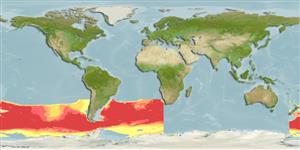Common names from other countries
Classification / Names / Names
Nomi Comuni | Sinonimi | Catalog of Fishes (gen., sp.) | ITIS | CoL | WoRMS
Environment: milieu / climate zone / depth range / distribution range
Ecologia
; distribuzione batimetrica 500 - 1000 m (Ref. 275). Polar; 29°S - 74°S, 167°E - 16°E (Ref. 275)
Atlantic, Indo-Pacific and the Antarctic.
Length at first maturity / Size / Peso / Age
Maturity: Lm ? range ? - ? cm Max length : 9.0 cm ML maschio/sesso non determinato; (Ref. 275)
Oceanic; occurring in equatorial, southern subtropical, southern peripheral water masses. Paralarvae are epipelagic and mesopelagic; adults are lower epipelagic, mesopelagic and bathypelagic. Predators include the dwarf sperm whale, Kogia sima, off Brazil, pygmy sperm whale, K. breviceps, off New Zealand, the southern elephant seal, Miroungia leonina, and fishes, such as hakes and macrurids. A principal prey item seems to be krill (Ref. 97142).
Life cycle and mating behavior
Maturità | Riproduzione | Deposizione | Uova | Fecundity | Larve
Members of the class Cephalopoda are gonochoric. Male and female adults usually die shortly after spawning and brooding, respectively. Mating behavior: Males perform various displays to attract potential females for copulation. During copulation, male grasp the female and inserts the hectocotylus into the female's mantle cavity where fertilization usually occurs. Life cycle: Embryos hatch into planktonic stage and live for some time before they grow larger and take up a benthic existence as adults.
Roper, C.F.E., M.J. Sweeney and C.E. Nauen. 1984. (Ref. 275)
IUCN Red List Status (Ref. 130435)
CITES status (Ref. 108899)
Not Evaluated
Not Evaluated
Human uses
| FishSource |
Strumenti
Informazioni ulteriori
Age/SizeAccrescimentoLength-weightLength-lengthMorfologiaLarveAbbondanza
Fonti Internet
Estimates based on models
Preferred temperature
(Ref.
115969): -0.2 - 2, mean 0.4 (based on 18 cells).
Vulnerability
Low vulnerability (10 of 100).
